WBS Bank's Risk Management: Analysis of Trading Book and VaR
VerifiedAdded on 2023/06/15
|13
|3549
|251
Report
AI Summary
This report provides a comprehensive analysis of risk management strategies employed by WBS Bank. It quantifies the implications of new security purchases on reserve requirements and liquidity risk, demonstrating how higher reserves are needed and liquidation costs increase with new additions to the trading book. The report explores duration gap management as a tool for mitigating interest rate risk, highlighting potential losses from asset-liability mismatches during interest rate increases. Value at Risk (VaR) and Expected Shortfall are discussed as key risk measures, with VaR calculated at £10211750 for WBS Bank's portfolio. Finally, the report examines the effectiveness of the Basel III framework, noting its impact on capital adequacy ratio volatility and its role in stabilizing loan-to-asset ratios.
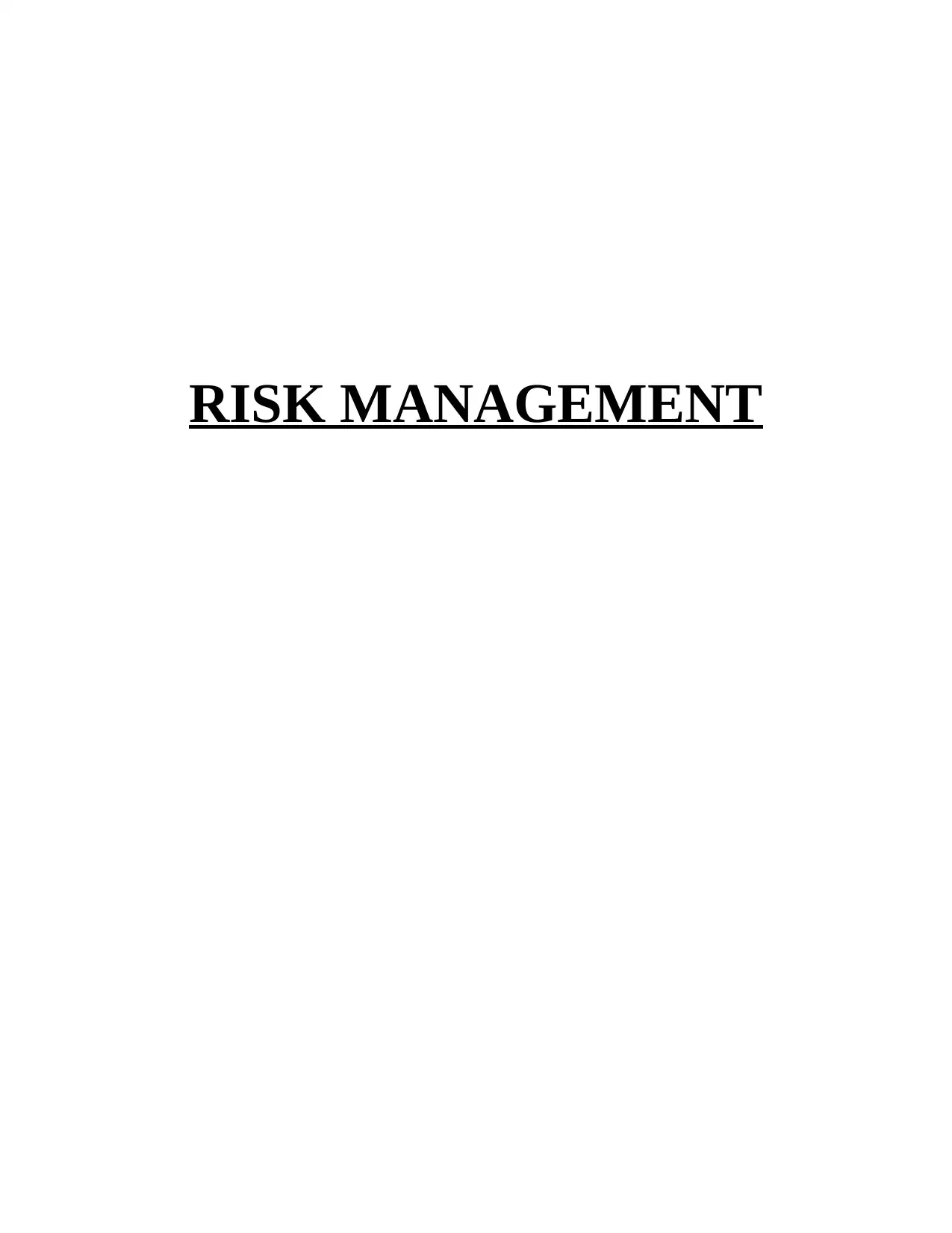
RISK MANAGEMENT
Paraphrase This Document
Need a fresh take? Get an instant paraphrase of this document with our AI Paraphraser
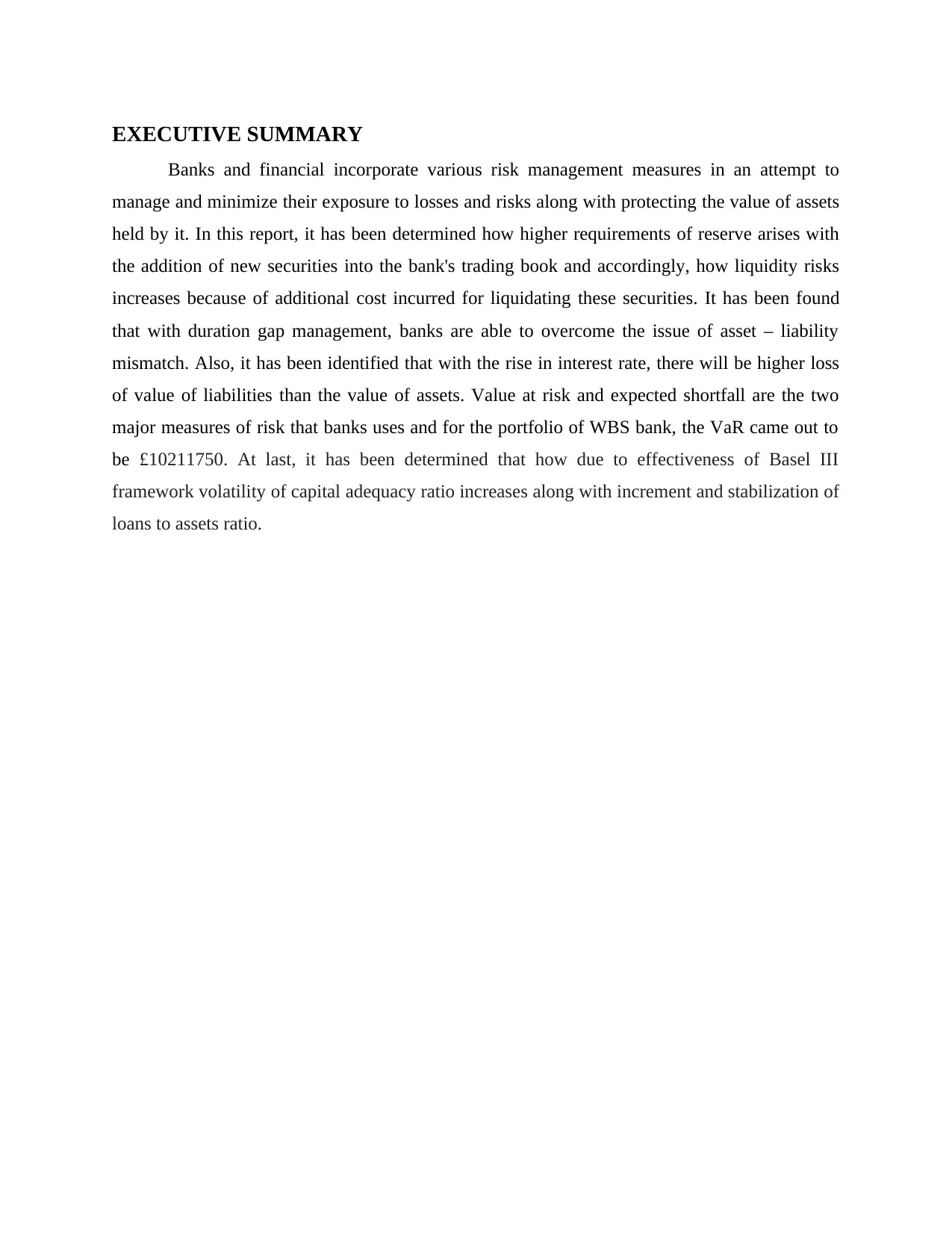
EXECUTIVE SUMMARY
Banks and financial incorporate various risk management measures in an attempt to
manage and minimize their exposure to losses and risks along with protecting the value of assets
held by it. In this report, it has been determined how higher requirements of reserve arises with
the addition of new securities into the bank's trading book and accordingly, how liquidity risks
increases because of additional cost incurred for liquidating these securities. It has been found
that with duration gap management, banks are able to overcome the issue of asset – liability
mismatch. Also, it has been identified that with the rise in interest rate, there will be higher loss
of value of liabilities than the value of assets. Value at risk and expected shortfall are the two
major measures of risk that banks uses and for the portfolio of WBS bank, the VaR came out to
be £10211750. At last, it has been determined that how due to effectiveness of Basel III
framework volatility of capital adequacy ratio increases along with increment and stabilization of
loans to assets ratio.
Banks and financial incorporate various risk management measures in an attempt to
manage and minimize their exposure to losses and risks along with protecting the value of assets
held by it. In this report, it has been determined how higher requirements of reserve arises with
the addition of new securities into the bank's trading book and accordingly, how liquidity risks
increases because of additional cost incurred for liquidating these securities. It has been found
that with duration gap management, banks are able to overcome the issue of asset – liability
mismatch. Also, it has been identified that with the rise in interest rate, there will be higher loss
of value of liabilities than the value of assets. Value at risk and expected shortfall are the two
major measures of risk that banks uses and for the portfolio of WBS bank, the VaR came out to
be £10211750. At last, it has been determined that how due to effectiveness of Basel III
framework volatility of capital adequacy ratio increases along with increment and stabilization of
loans to assets ratio.
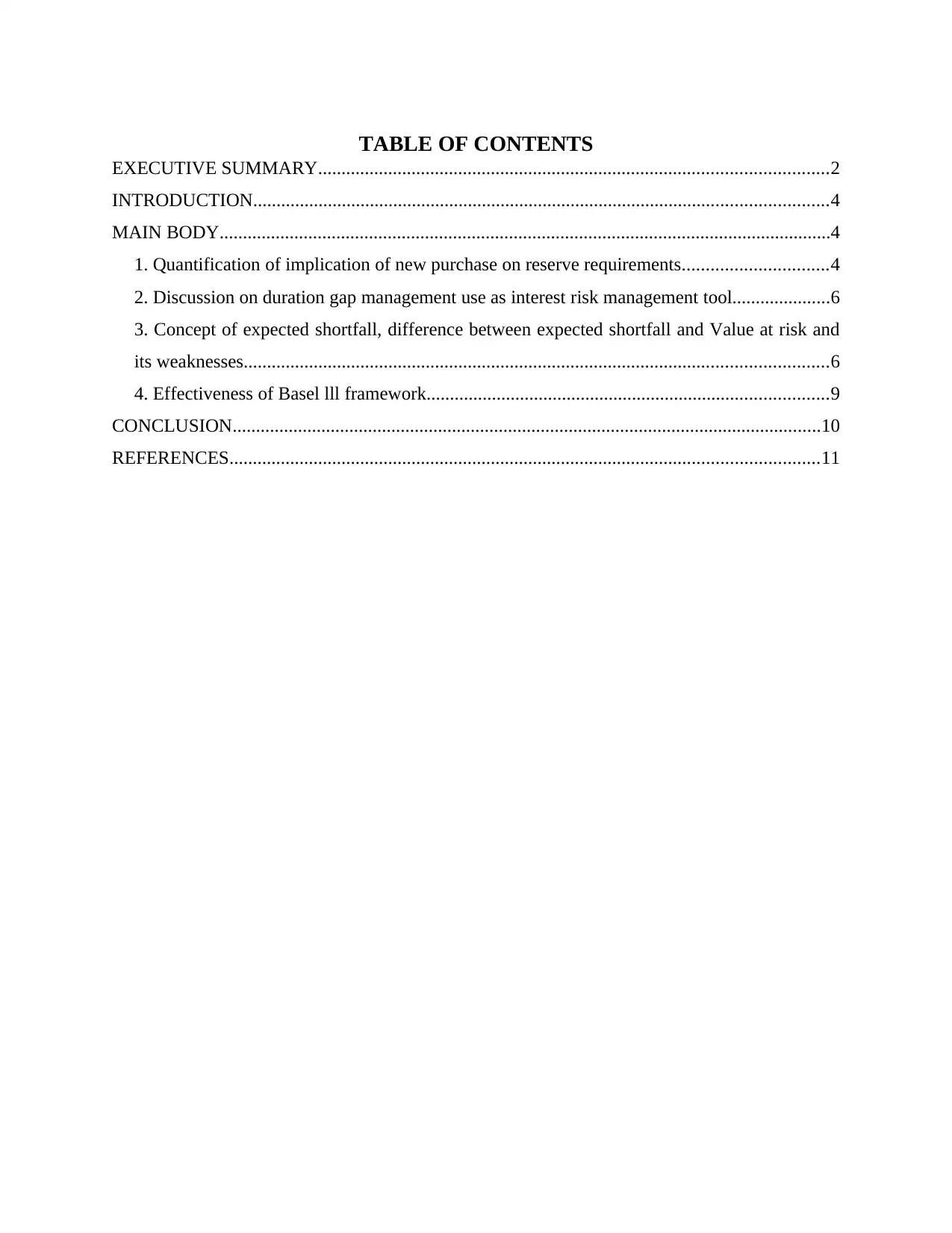
TABLE OF CONTENTS
EXECUTIVE SUMMARY.............................................................................................................2
INTRODUCTION...........................................................................................................................4
MAIN BODY...................................................................................................................................4
1. Quantification of implication of new purchase on reserve requirements...............................4
2. Discussion on duration gap management use as interest risk management tool.....................6
3. Concept of expected shortfall, difference between expected shortfall and Value at risk and
its weaknesses.............................................................................................................................6
4. Effectiveness of Basel lll framework......................................................................................9
CONCLUSION..............................................................................................................................10
REFERENCES..............................................................................................................................11
EXECUTIVE SUMMARY.............................................................................................................2
INTRODUCTION...........................................................................................................................4
MAIN BODY...................................................................................................................................4
1. Quantification of implication of new purchase on reserve requirements...............................4
2. Discussion on duration gap management use as interest risk management tool.....................6
3. Concept of expected shortfall, difference between expected shortfall and Value at risk and
its weaknesses.............................................................................................................................6
4. Effectiveness of Basel lll framework......................................................................................9
CONCLUSION..............................................................................................................................10
REFERENCES..............................................................................................................................11
⊘ This is a preview!⊘
Do you want full access?
Subscribe today to unlock all pages.

Trusted by 1+ million students worldwide
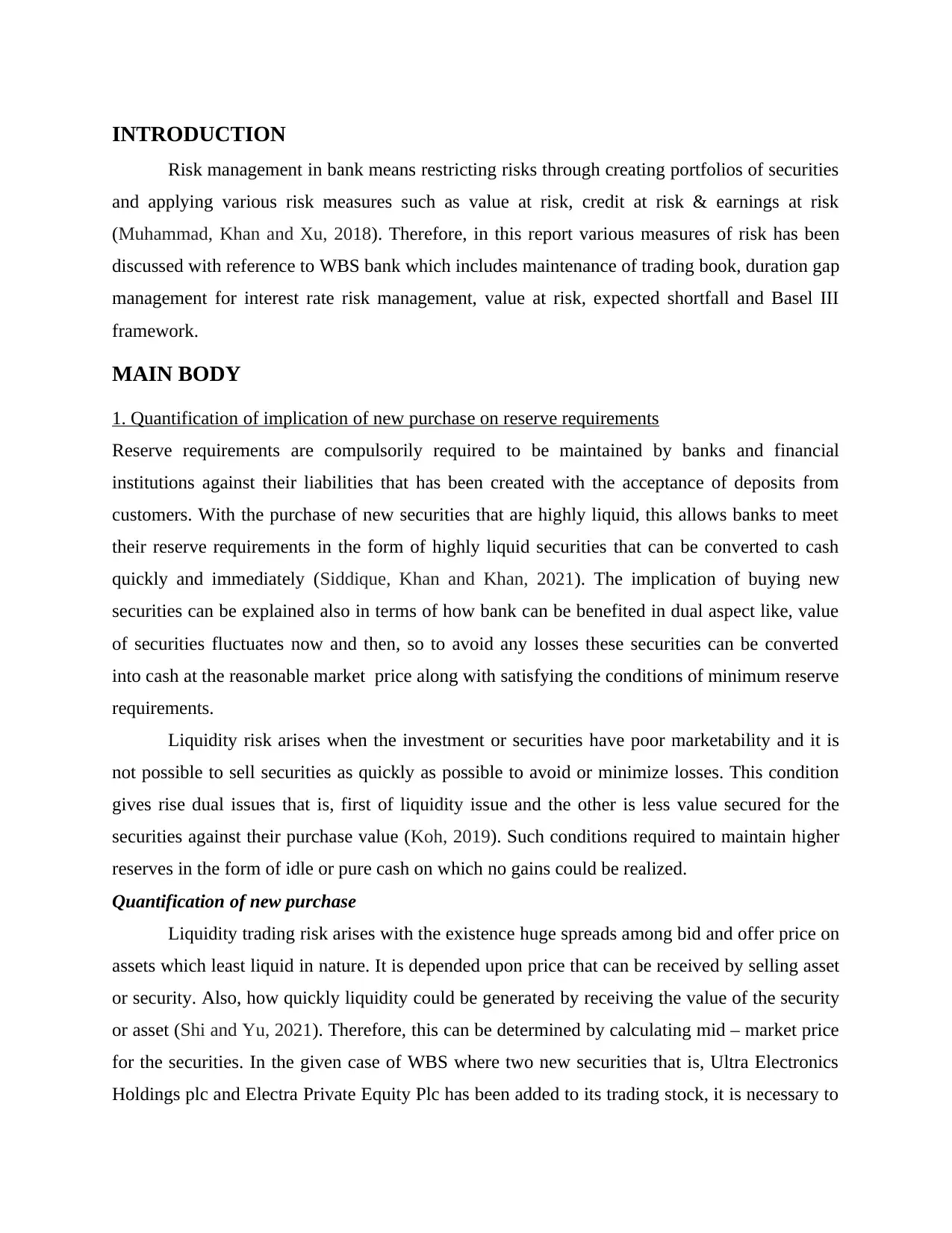
INTRODUCTION
Risk management in bank means restricting risks through creating portfolios of securities
and applying various risk measures such as value at risk, credit at risk & earnings at risk
(Muhammad, Khan and Xu, 2018). Therefore, in this report various measures of risk has been
discussed with reference to WBS bank which includes maintenance of trading book, duration gap
management for interest rate risk management, value at risk, expected shortfall and Basel III
framework.
MAIN BODY
1. Quantification of implication of new purchase on reserve requirements
Reserve requirements are compulsorily required to be maintained by banks and financial
institutions against their liabilities that has been created with the acceptance of deposits from
customers. With the purchase of new securities that are highly liquid, this allows banks to meet
their reserve requirements in the form of highly liquid securities that can be converted to cash
quickly and immediately (Siddique, Khan and Khan, 2021). The implication of buying new
securities can be explained also in terms of how bank can be benefited in dual aspect like, value
of securities fluctuates now and then, so to avoid any losses these securities can be converted
into cash at the reasonable market price along with satisfying the conditions of minimum reserve
requirements.
Liquidity risk arises when the investment or securities have poor marketability and it is
not possible to sell securities as quickly as possible to avoid or minimize losses. This condition
gives rise dual issues that is, first of liquidity issue and the other is less value secured for the
securities against their purchase value (Koh, 2019). Such conditions required to maintain higher
reserves in the form of idle or pure cash on which no gains could be realized.
Quantification of new purchase
Liquidity trading risk arises with the existence huge spreads among bid and offer price on
assets which least liquid in nature. It is depended upon price that can be received by selling asset
or security. Also, how quickly liquidity could be generated by receiving the value of the security
or asset (Shi and Yu, 2021). Therefore, this can be determined by calculating mid – market price
for the securities. In the given case of WBS where two new securities that is, Ultra Electronics
Holdings plc and Electra Private Equity Plc has been added to its trading stock, it is necessary to
Risk management in bank means restricting risks through creating portfolios of securities
and applying various risk measures such as value at risk, credit at risk & earnings at risk
(Muhammad, Khan and Xu, 2018). Therefore, in this report various measures of risk has been
discussed with reference to WBS bank which includes maintenance of trading book, duration gap
management for interest rate risk management, value at risk, expected shortfall and Basel III
framework.
MAIN BODY
1. Quantification of implication of new purchase on reserve requirements
Reserve requirements are compulsorily required to be maintained by banks and financial
institutions against their liabilities that has been created with the acceptance of deposits from
customers. With the purchase of new securities that are highly liquid, this allows banks to meet
their reserve requirements in the form of highly liquid securities that can be converted to cash
quickly and immediately (Siddique, Khan and Khan, 2021). The implication of buying new
securities can be explained also in terms of how bank can be benefited in dual aspect like, value
of securities fluctuates now and then, so to avoid any losses these securities can be converted
into cash at the reasonable market price along with satisfying the conditions of minimum reserve
requirements.
Liquidity risk arises when the investment or securities have poor marketability and it is
not possible to sell securities as quickly as possible to avoid or minimize losses. This condition
gives rise dual issues that is, first of liquidity issue and the other is less value secured for the
securities against their purchase value (Koh, 2019). Such conditions required to maintain higher
reserves in the form of idle or pure cash on which no gains could be realized.
Quantification of new purchase
Liquidity trading risk arises with the existence huge spreads among bid and offer price on
assets which least liquid in nature. It is depended upon price that can be received by selling asset
or security. Also, how quickly liquidity could be generated by receiving the value of the security
or asset (Shi and Yu, 2021). Therefore, this can be determined by calculating mid – market price
for the securities. In the given case of WBS where two new securities that is, Ultra Electronics
Holdings plc and Electra Private Equity Plc has been added to its trading stock, it is necessary to
Paraphrase This Document
Need a fresh take? Get an instant paraphrase of this document with our AI Paraphraser
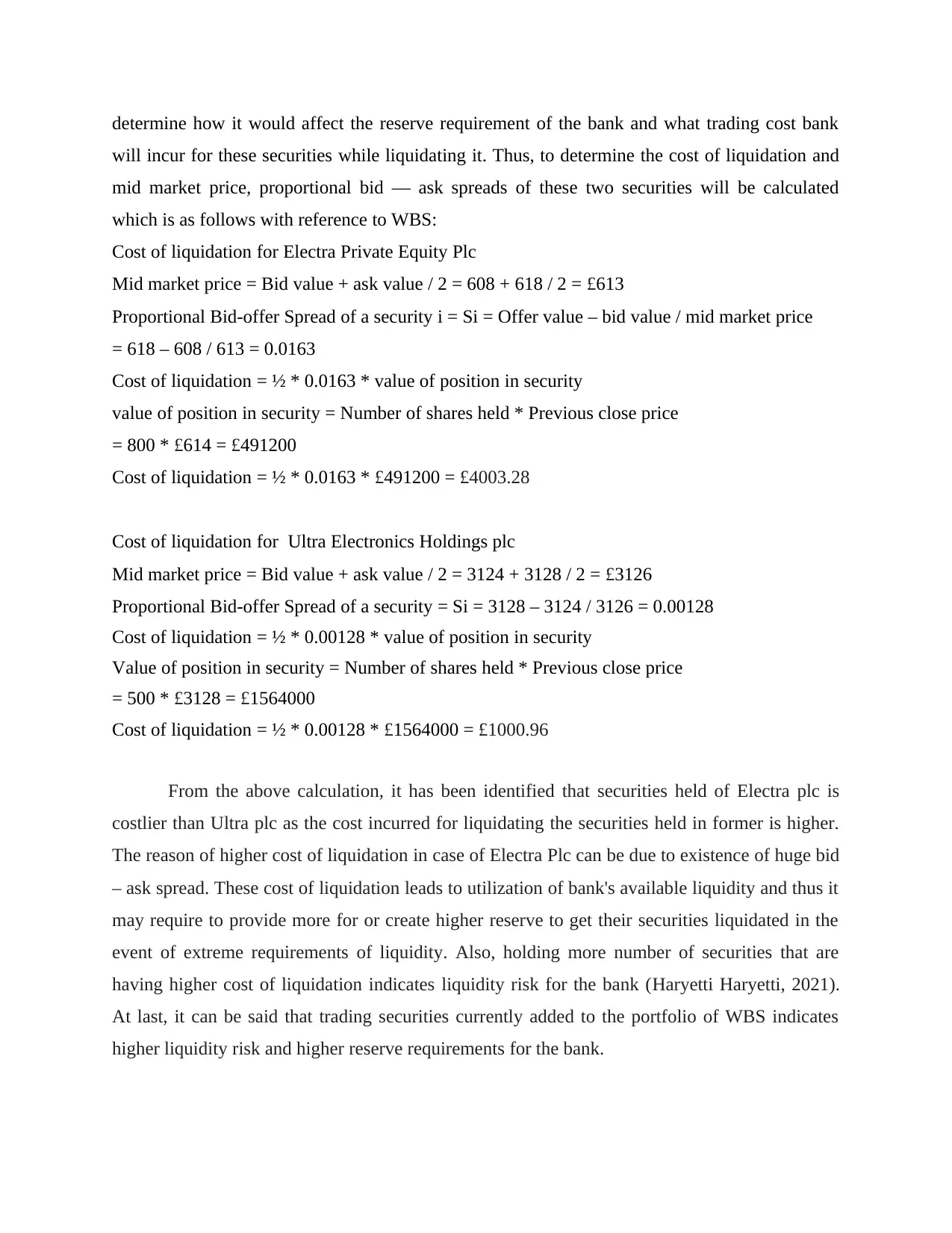
determine how it would affect the reserve requirement of the bank and what trading cost bank
will incur for these securities while liquidating it. Thus, to determine the cost of liquidation and
mid market price, proportional bid — ask spreads of these two securities will be calculated
which is as follows with reference to WBS:
Cost of liquidation for Electra Private Equity Plc
Mid market price = Bid value + ask value / 2 = 608 + 618 / 2 = £613
Proportional Bid-offer Spread of a security i = Si = Offer value – bid value / mid market price
= 618 – 608 / 613 = 0.0163
Cost of liquidation = ½ * 0.0163 * value of position in security
value of position in security = Number of shares held * Previous close price
= 800 * £614 = £491200
Cost of liquidation = ½ * 0.0163 * £491200 = £4003.28
Cost of liquidation for Ultra Electronics Holdings plc
Mid market price = Bid value + ask value / 2 = 3124 + 3128 / 2 = £3126
Proportional Bid-offer Spread of a security = Si = 3128 – 3124 / 3126 = 0.00128
Cost of liquidation = ½ * 0.00128 * value of position in security
Value of position in security = Number of shares held * Previous close price
= 500 * £3128 = £1564000
Cost of liquidation = ½ * 0.00128 * £1564000 = £1000.96
From the above calculation, it has been identified that securities held of Electra plc is
costlier than Ultra plc as the cost incurred for liquidating the securities held in former is higher.
The reason of higher cost of liquidation in case of Electra Plc can be due to existence of huge bid
– ask spread. These cost of liquidation leads to utilization of bank's available liquidity and thus it
may require to provide more for or create higher reserve to get their securities liquidated in the
event of extreme requirements of liquidity. Also, holding more number of securities that are
having higher cost of liquidation indicates liquidity risk for the bank (Haryetti Haryetti, 2021).
At last, it can be said that trading securities currently added to the portfolio of WBS indicates
higher liquidity risk and higher reserve requirements for the bank.
will incur for these securities while liquidating it. Thus, to determine the cost of liquidation and
mid market price, proportional bid — ask spreads of these two securities will be calculated
which is as follows with reference to WBS:
Cost of liquidation for Electra Private Equity Plc
Mid market price = Bid value + ask value / 2 = 608 + 618 / 2 = £613
Proportional Bid-offer Spread of a security i = Si = Offer value – bid value / mid market price
= 618 – 608 / 613 = 0.0163
Cost of liquidation = ½ * 0.0163 * value of position in security
value of position in security = Number of shares held * Previous close price
= 800 * £614 = £491200
Cost of liquidation = ½ * 0.0163 * £491200 = £4003.28
Cost of liquidation for Ultra Electronics Holdings plc
Mid market price = Bid value + ask value / 2 = 3124 + 3128 / 2 = £3126
Proportional Bid-offer Spread of a security = Si = 3128 – 3124 / 3126 = 0.00128
Cost of liquidation = ½ * 0.00128 * value of position in security
Value of position in security = Number of shares held * Previous close price
= 500 * £3128 = £1564000
Cost of liquidation = ½ * 0.00128 * £1564000 = £1000.96
From the above calculation, it has been identified that securities held of Electra plc is
costlier than Ultra plc as the cost incurred for liquidating the securities held in former is higher.
The reason of higher cost of liquidation in case of Electra Plc can be due to existence of huge bid
– ask spread. These cost of liquidation leads to utilization of bank's available liquidity and thus it
may require to provide more for or create higher reserve to get their securities liquidated in the
event of extreme requirements of liquidity. Also, holding more number of securities that are
having higher cost of liquidation indicates liquidity risk for the bank (Haryetti Haryetti, 2021).
At last, it can be said that trading securities currently added to the portfolio of WBS indicates
higher liquidity risk and higher reserve requirements for the bank.
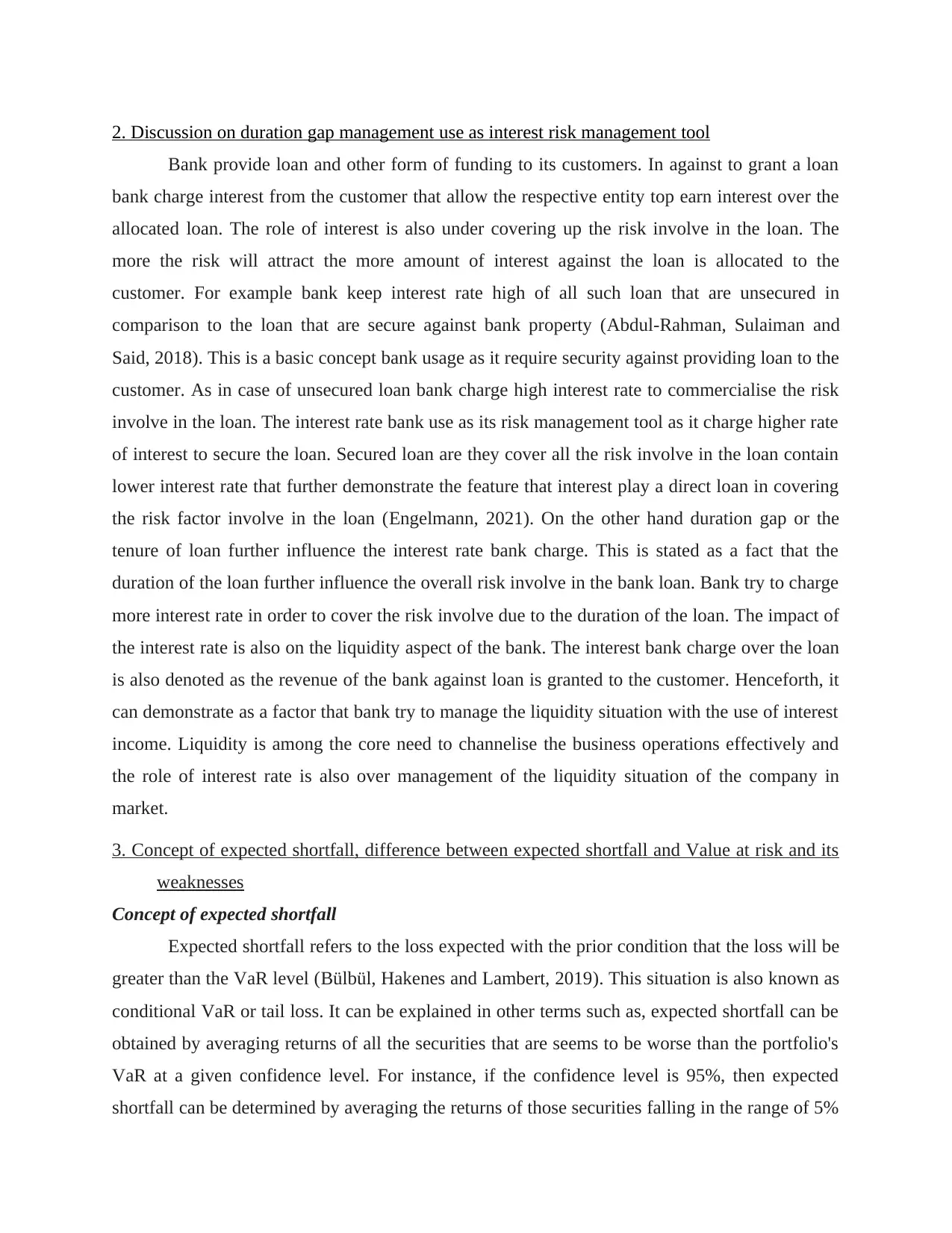
2. Discussion on duration gap management use as interest risk management tool
Bank provide loan and other form of funding to its customers. In against to grant a loan
bank charge interest from the customer that allow the respective entity top earn interest over the
allocated loan. The role of interest is also under covering up the risk involve in the loan. The
more the risk will attract the more amount of interest against the loan is allocated to the
customer. For example bank keep interest rate high of all such loan that are unsecured in
comparison to the loan that are secure against bank property (Abdul-Rahman, Sulaiman and
Said, 2018). This is a basic concept bank usage as it require security against providing loan to the
customer. As in case of unsecured loan bank charge high interest rate to commercialise the risk
involve in the loan. The interest rate bank use as its risk management tool as it charge higher rate
of interest to secure the loan. Secured loan are they cover all the risk involve in the loan contain
lower interest rate that further demonstrate the feature that interest play a direct loan in covering
the risk factor involve in the loan (Engelmann, 2021). On the other hand duration gap or the
tenure of loan further influence the interest rate bank charge. This is stated as a fact that the
duration of the loan further influence the overall risk involve in the bank loan. Bank try to charge
more interest rate in order to cover the risk involve due to the duration of the loan. The impact of
the interest rate is also on the liquidity aspect of the bank. The interest bank charge over the loan
is also denoted as the revenue of the bank against loan is granted to the customer. Henceforth, it
can demonstrate as a factor that bank try to manage the liquidity situation with the use of interest
income. Liquidity is among the core need to channelise the business operations effectively and
the role of interest rate is also over management of the liquidity situation of the company in
market.
3. Concept of expected shortfall, difference between expected shortfall and Value at risk and its
weaknesses
Concept of expected shortfall
Expected shortfall refers to the loss expected with the prior condition that the loss will be
greater than the VaR level (Bülbül, Hakenes and Lambert, 2019). This situation is also known as
conditional VaR or tail loss. It can be explained in other terms such as, expected shortfall can be
obtained by averaging returns of all the securities that are seems to be worse than the portfolio's
VaR at a given confidence level. For instance, if the confidence level is 95%, then expected
shortfall can be determined by averaging the returns of those securities falling in the range of 5%
Bank provide loan and other form of funding to its customers. In against to grant a loan
bank charge interest from the customer that allow the respective entity top earn interest over the
allocated loan. The role of interest is also under covering up the risk involve in the loan. The
more the risk will attract the more amount of interest against the loan is allocated to the
customer. For example bank keep interest rate high of all such loan that are unsecured in
comparison to the loan that are secure against bank property (Abdul-Rahman, Sulaiman and
Said, 2018). This is a basic concept bank usage as it require security against providing loan to the
customer. As in case of unsecured loan bank charge high interest rate to commercialise the risk
involve in the loan. The interest rate bank use as its risk management tool as it charge higher rate
of interest to secure the loan. Secured loan are they cover all the risk involve in the loan contain
lower interest rate that further demonstrate the feature that interest play a direct loan in covering
the risk factor involve in the loan (Engelmann, 2021). On the other hand duration gap or the
tenure of loan further influence the interest rate bank charge. This is stated as a fact that the
duration of the loan further influence the overall risk involve in the bank loan. Bank try to charge
more interest rate in order to cover the risk involve due to the duration of the loan. The impact of
the interest rate is also on the liquidity aspect of the bank. The interest bank charge over the loan
is also denoted as the revenue of the bank against loan is granted to the customer. Henceforth, it
can demonstrate as a factor that bank try to manage the liquidity situation with the use of interest
income. Liquidity is among the core need to channelise the business operations effectively and
the role of interest rate is also over management of the liquidity situation of the company in
market.
3. Concept of expected shortfall, difference between expected shortfall and Value at risk and its
weaknesses
Concept of expected shortfall
Expected shortfall refers to the loss expected with the prior condition that the loss will be
greater than the VaR level (Bülbül, Hakenes and Lambert, 2019). This situation is also known as
conditional VaR or tail loss. It can be explained in other terms such as, expected shortfall can be
obtained by averaging returns of all the securities that are seems to be worse than the portfolio's
VaR at a given confidence level. For instance, if the confidence level is 95%, then expected
shortfall can be determined by averaging the returns of those securities falling in the range of 5%
⊘ This is a preview!⊘
Do you want full access?
Subscribe today to unlock all pages.

Trusted by 1+ million students worldwide
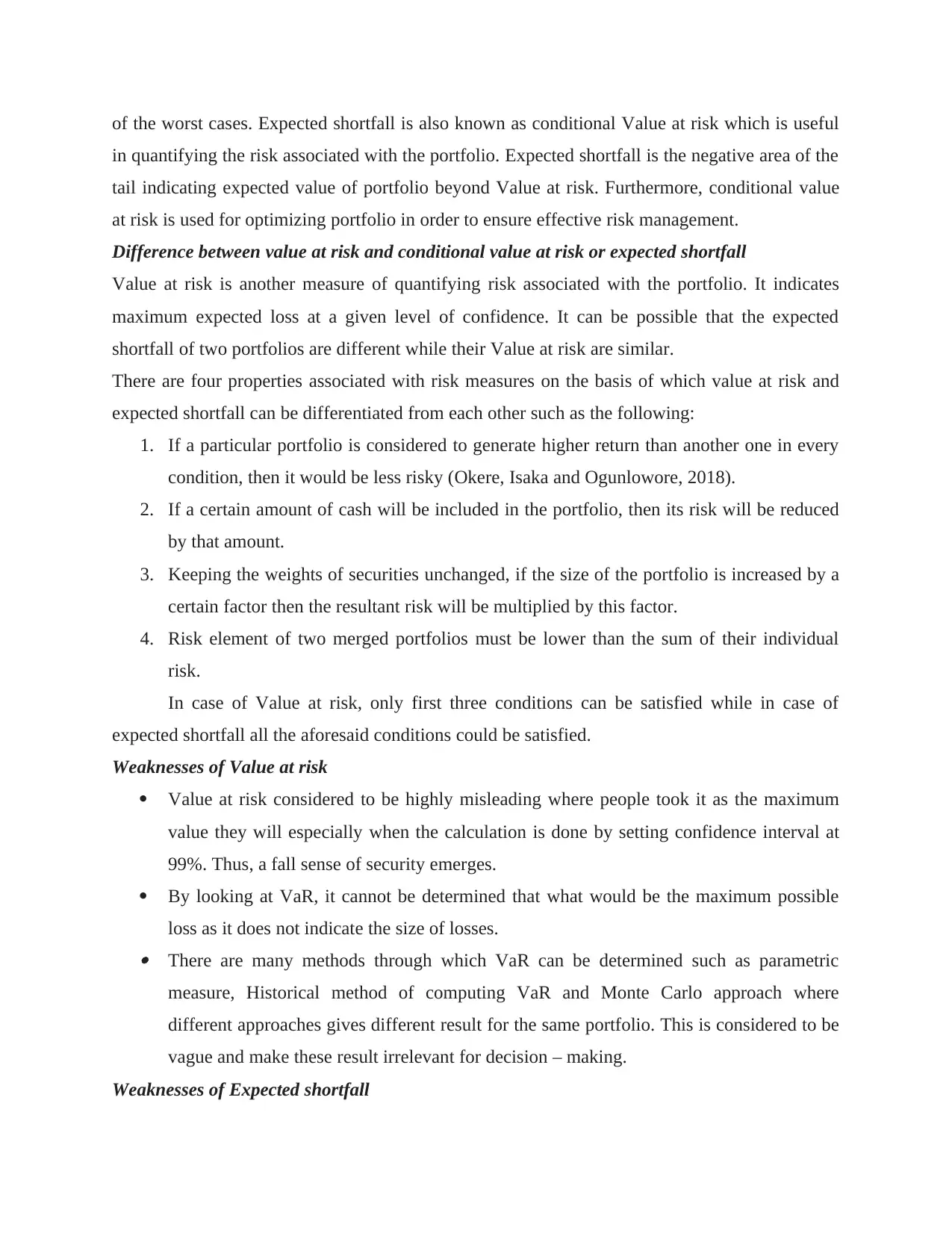
of the worst cases. Expected shortfall is also known as conditional Value at risk which is useful
in quantifying the risk associated with the portfolio. Expected shortfall is the negative area of the
tail indicating expected value of portfolio beyond Value at risk. Furthermore, conditional value
at risk is used for optimizing portfolio in order to ensure effective risk management.
Difference between value at risk and conditional value at risk or expected shortfall
Value at risk is another measure of quantifying risk associated with the portfolio. It indicates
maximum expected loss at a given level of confidence. It can be possible that the expected
shortfall of two portfolios are different while their Value at risk are similar.
There are four properties associated with risk measures on the basis of which value at risk and
expected shortfall can be differentiated from each other such as the following:
1. If a particular portfolio is considered to generate higher return than another one in every
condition, then it would be less risky (Okere, Isaka and Ogunlowore, 2018).
2. If a certain amount of cash will be included in the portfolio, then its risk will be reduced
by that amount.
3. Keeping the weights of securities unchanged, if the size of the portfolio is increased by a
certain factor then the resultant risk will be multiplied by this factor.
4. Risk element of two merged portfolios must be lower than the sum of their individual
risk.
In case of Value at risk, only first three conditions can be satisfied while in case of
expected shortfall all the aforesaid conditions could be satisfied.
Weaknesses of Value at risk
Value at risk considered to be highly misleading where people took it as the maximum
value they will especially when the calculation is done by setting confidence interval at
99%. Thus, a fall sense of security emerges.
By looking at VaR, it cannot be determined that what would be the maximum possible
loss as it does not indicate the size of losses. There are many methods through which VaR can be determined such as parametric
measure, Historical method of computing VaR and Monte Carlo approach where
different approaches gives different result for the same portfolio. This is considered to be
vague and make these result irrelevant for decision – making.
Weaknesses of Expected shortfall
in quantifying the risk associated with the portfolio. Expected shortfall is the negative area of the
tail indicating expected value of portfolio beyond Value at risk. Furthermore, conditional value
at risk is used for optimizing portfolio in order to ensure effective risk management.
Difference between value at risk and conditional value at risk or expected shortfall
Value at risk is another measure of quantifying risk associated with the portfolio. It indicates
maximum expected loss at a given level of confidence. It can be possible that the expected
shortfall of two portfolios are different while their Value at risk are similar.
There are four properties associated with risk measures on the basis of which value at risk and
expected shortfall can be differentiated from each other such as the following:
1. If a particular portfolio is considered to generate higher return than another one in every
condition, then it would be less risky (Okere, Isaka and Ogunlowore, 2018).
2. If a certain amount of cash will be included in the portfolio, then its risk will be reduced
by that amount.
3. Keeping the weights of securities unchanged, if the size of the portfolio is increased by a
certain factor then the resultant risk will be multiplied by this factor.
4. Risk element of two merged portfolios must be lower than the sum of their individual
risk.
In case of Value at risk, only first three conditions can be satisfied while in case of
expected shortfall all the aforesaid conditions could be satisfied.
Weaknesses of Value at risk
Value at risk considered to be highly misleading where people took it as the maximum
value they will especially when the calculation is done by setting confidence interval at
99%. Thus, a fall sense of security emerges.
By looking at VaR, it cannot be determined that what would be the maximum possible
loss as it does not indicate the size of losses. There are many methods through which VaR can be determined such as parametric
measure, Historical method of computing VaR and Monte Carlo approach where
different approaches gives different result for the same portfolio. This is considered to be
vague and make these result irrelevant for decision – making.
Weaknesses of Expected shortfall
Paraphrase This Document
Need a fresh take? Get an instant paraphrase of this document with our AI Paraphraser
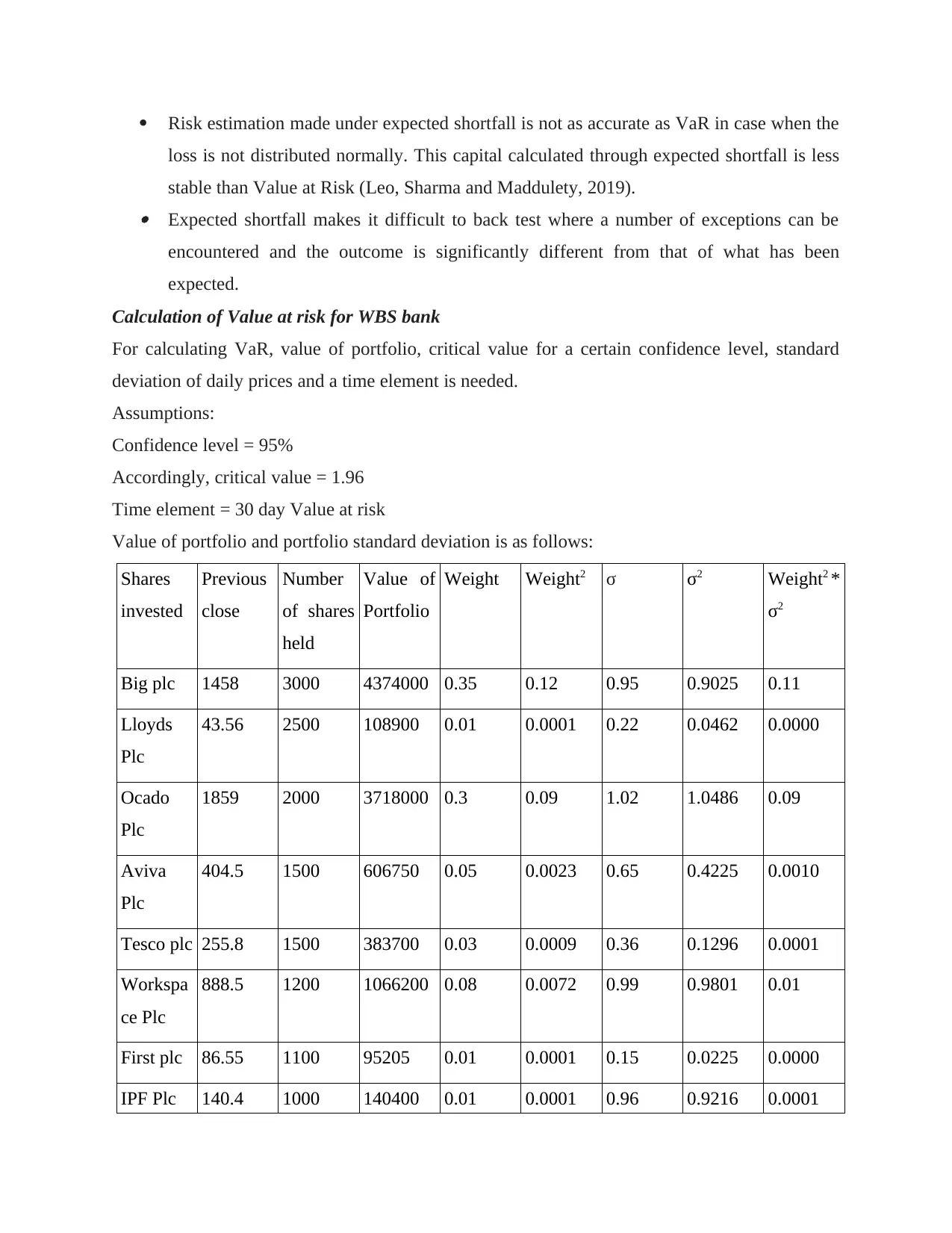
Risk estimation made under expected shortfall is not as accurate as VaR in case when the
loss is not distributed normally. This capital calculated through expected shortfall is less
stable than Value at Risk (Leo, Sharma and Maddulety, 2019). Expected shortfall makes it difficult to back test where a number of exceptions can be
encountered and the outcome is significantly different from that of what has been
expected.
Calculation of Value at risk for WBS bank
For calculating VaR, value of portfolio, critical value for a certain confidence level, standard
deviation of daily prices and a time element is needed.
Assumptions:
Confidence level = 95%
Accordingly, critical value = 1.96
Time element = 30 day Value at risk
Value of portfolio and portfolio standard deviation is as follows:
Shares
invested
Previous
close
Number
of shares
held
Value of
Portfolio
Weight Weight2 σ σ2 Weight2 *
σ2
Big plc 1458 3000 4374000 0.35 0.12 0.95 0.9025 0.11
Lloyds
Plc
43.56 2500 108900 0.01 0.0001 0.22 0.0462 0.0000
Ocado
Plc
1859 2000 3718000 0.3 0.09 1.02 1.0486 0.09
Aviva
Plc
404.5 1500 606750 0.05 0.0023 0.65 0.4225 0.0010
Tesco plc 255.8 1500 383700 0.03 0.0009 0.36 0.1296 0.0001
Workspa
ce Plc
888.5 1200 1066200 0.08 0.0072 0.99 0.9801 0.01
First plc 86.55 1100 95205 0.01 0.0001 0.15 0.0225 0.0000
IPF Plc 140.4 1000 140400 0.01 0.0001 0.96 0.9216 0.0001
loss is not distributed normally. This capital calculated through expected shortfall is less
stable than Value at Risk (Leo, Sharma and Maddulety, 2019). Expected shortfall makes it difficult to back test where a number of exceptions can be
encountered and the outcome is significantly different from that of what has been
expected.
Calculation of Value at risk for WBS bank
For calculating VaR, value of portfolio, critical value for a certain confidence level, standard
deviation of daily prices and a time element is needed.
Assumptions:
Confidence level = 95%
Accordingly, critical value = 1.96
Time element = 30 day Value at risk
Value of portfolio and portfolio standard deviation is as follows:
Shares
invested
Previous
close
Number
of shares
held
Value of
Portfolio
Weight Weight2 σ σ2 Weight2 *
σ2
Big plc 1458 3000 4374000 0.35 0.12 0.95 0.9025 0.11
Lloyds
Plc
43.56 2500 108900 0.01 0.0001 0.22 0.0462 0.0000
Ocado
Plc
1859 2000 3718000 0.3 0.09 1.02 1.0486 0.09
Aviva
Plc
404.5 1500 606750 0.05 0.0023 0.65 0.4225 0.0010
Tesco plc 255.8 1500 383700 0.03 0.0009 0.36 0.1296 0.0001
Workspa
ce Plc
888.5 1200 1066200 0.08 0.0072 0.99 0.9801 0.01
First plc 86.55 1100 95205 0.01 0.0001 0.15 0.0225 0.0000
IPF Plc 140.4 1000 140400 0.01 0.0001 0.96 0.9216 0.0001
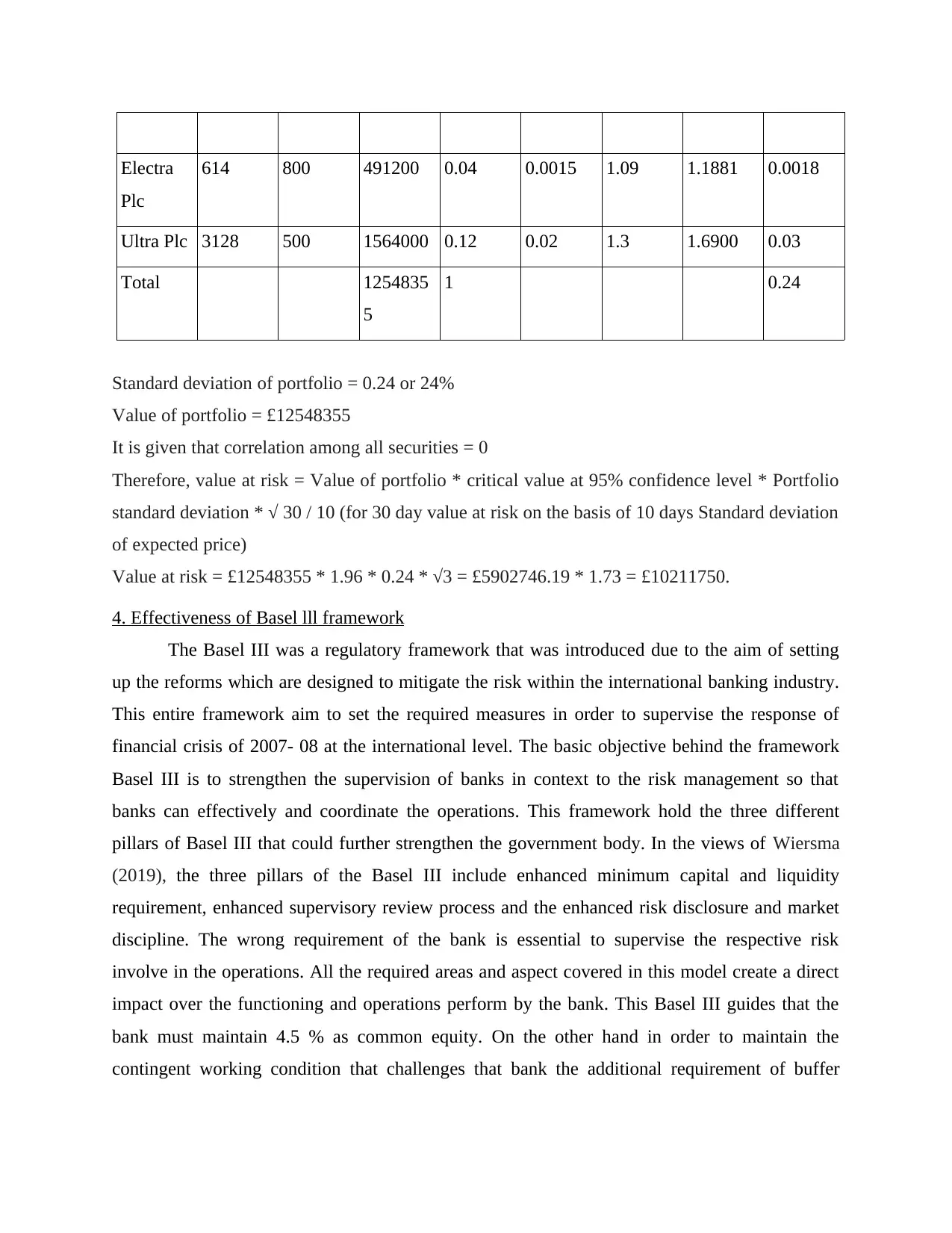
Electra
Plc
614 800 491200 0.04 0.0015 1.09 1.1881 0.0018
Ultra Plc 3128 500 1564000 0.12 0.02 1.3 1.6900 0.03
Total 1254835
5
1 0.24
Standard deviation of portfolio = 0.24 or 24%
Value of portfolio = £12548355
It is given that correlation among all securities = 0
Therefore, value at risk = Value of portfolio * critical value at 95% confidence level * Portfolio
standard deviation * √ 30 / 10 (for 30 day value at risk on the basis of 10 days Standard deviation
of expected price)
Value at risk = £12548355 * 1.96 * 0.24 * √3 = £5902746.19 * 1.73 = £10211750.
4. Effectiveness of Basel lll framework
The Basel III was a regulatory framework that was introduced due to the aim of setting
up the reforms which are designed to mitigate the risk within the international banking industry.
This entire framework aim to set the required measures in order to supervise the response of
financial crisis of 2007- 08 at the international level. The basic objective behind the framework
Basel III is to strengthen the supervision of banks in context to the risk management so that
banks can effectively and coordinate the operations. This framework hold the three different
pillars of Basel III that could further strengthen the government body. In the views of Wiersma
(2019), the three pillars of the Basel III include enhanced minimum capital and liquidity
requirement, enhanced supervisory review process and the enhanced risk disclosure and market
discipline. The wrong requirement of the bank is essential to supervise the respective risk
involve in the operations. All the required areas and aspect covered in this model create a direct
impact over the functioning and operations perform by the bank. This Basel III guides that the
bank must maintain 4.5 % as common equity. On the other hand in order to maintain the
contingent working condition that challenges that bank the additional requirement of buffer
Plc
614 800 491200 0.04 0.0015 1.09 1.1881 0.0018
Ultra Plc 3128 500 1564000 0.12 0.02 1.3 1.6900 0.03
Total 1254835
5
1 0.24
Standard deviation of portfolio = 0.24 or 24%
Value of portfolio = £12548355
It is given that correlation among all securities = 0
Therefore, value at risk = Value of portfolio * critical value at 95% confidence level * Portfolio
standard deviation * √ 30 / 10 (for 30 day value at risk on the basis of 10 days Standard deviation
of expected price)
Value at risk = £12548355 * 1.96 * 0.24 * √3 = £5902746.19 * 1.73 = £10211750.
4. Effectiveness of Basel lll framework
The Basel III was a regulatory framework that was introduced due to the aim of setting
up the reforms which are designed to mitigate the risk within the international banking industry.
This entire framework aim to set the required measures in order to supervise the response of
financial crisis of 2007- 08 at the international level. The basic objective behind the framework
Basel III is to strengthen the supervision of banks in context to the risk management so that
banks can effectively and coordinate the operations. This framework hold the three different
pillars of Basel III that could further strengthen the government body. In the views of Wiersma
(2019), the three pillars of the Basel III include enhanced minimum capital and liquidity
requirement, enhanced supervisory review process and the enhanced risk disclosure and market
discipline. The wrong requirement of the bank is essential to supervise the respective risk
involve in the operations. All the required areas and aspect covered in this model create a direct
impact over the functioning and operations perform by the bank. This Basel III guides that the
bank must maintain 4.5 % as common equity. On the other hand in order to maintain the
contingent working condition that challenges that bank the additional requirement of buffer
⊘ This is a preview!⊘
Do you want full access?
Subscribe today to unlock all pages.

Trusted by 1+ million students worldwide
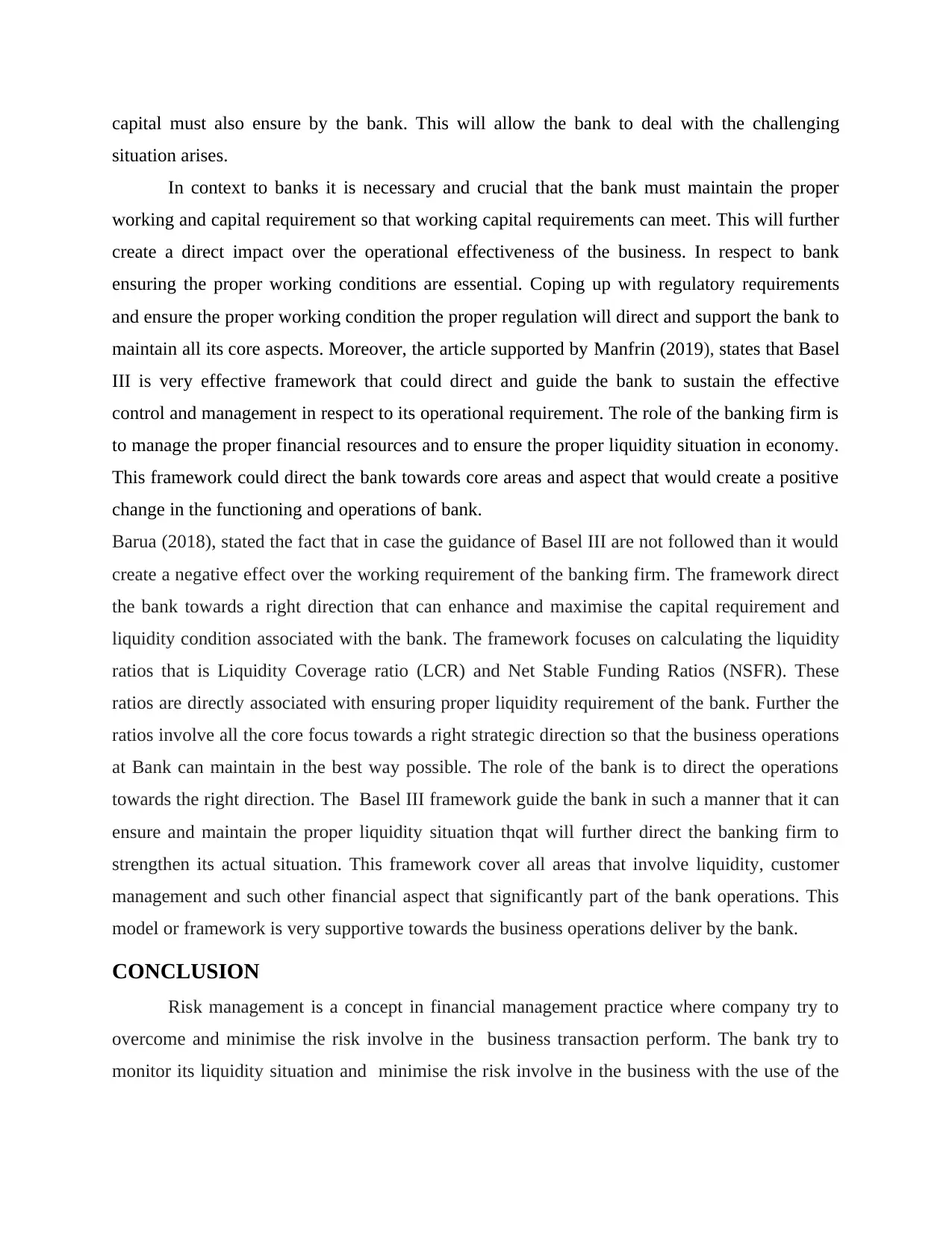
capital must also ensure by the bank. This will allow the bank to deal with the challenging
situation arises.
In context to banks it is necessary and crucial that the bank must maintain the proper
working and capital requirement so that working capital requirements can meet. This will further
create a direct impact over the operational effectiveness of the business. In respect to bank
ensuring the proper working conditions are essential. Coping up with regulatory requirements
and ensure the proper working condition the proper regulation will direct and support the bank to
maintain all its core aspects. Moreover, the article supported by Manfrin (2019), states that Basel
III is very effective framework that could direct and guide the bank to sustain the effective
control and management in respect to its operational requirement. The role of the banking firm is
to manage the proper financial resources and to ensure the proper liquidity situation in economy.
This framework could direct the bank towards core areas and aspect that would create a positive
change in the functioning and operations of bank.
Barua (2018), stated the fact that in case the guidance of Basel III are not followed than it would
create a negative effect over the working requirement of the banking firm. The framework direct
the bank towards a right direction that can enhance and maximise the capital requirement and
liquidity condition associated with the bank. The framework focuses on calculating the liquidity
ratios that is Liquidity Coverage ratio (LCR) and Net Stable Funding Ratios (NSFR). These
ratios are directly associated with ensuring proper liquidity requirement of the bank. Further the
ratios involve all the core focus towards a right strategic direction so that the business operations
at Bank can maintain in the best way possible. The role of the bank is to direct the operations
towards the right direction. The Basel III framework guide the bank in such a manner that it can
ensure and maintain the proper liquidity situation thqat will further direct the banking firm to
strengthen its actual situation. This framework cover all areas that involve liquidity, customer
management and such other financial aspect that significantly part of the bank operations. This
model or framework is very supportive towards the business operations deliver by the bank.
CONCLUSION
Risk management is a concept in financial management practice where company try to
overcome and minimise the risk involve in the business transaction perform. The bank try to
monitor its liquidity situation and minimise the risk involve in the business with the use of the
situation arises.
In context to banks it is necessary and crucial that the bank must maintain the proper
working and capital requirement so that working capital requirements can meet. This will further
create a direct impact over the operational effectiveness of the business. In respect to bank
ensuring the proper working conditions are essential. Coping up with regulatory requirements
and ensure the proper working condition the proper regulation will direct and support the bank to
maintain all its core aspects. Moreover, the article supported by Manfrin (2019), states that Basel
III is very effective framework that could direct and guide the bank to sustain the effective
control and management in respect to its operational requirement. The role of the banking firm is
to manage the proper financial resources and to ensure the proper liquidity situation in economy.
This framework could direct the bank towards core areas and aspect that would create a positive
change in the functioning and operations of bank.
Barua (2018), stated the fact that in case the guidance of Basel III are not followed than it would
create a negative effect over the working requirement of the banking firm. The framework direct
the bank towards a right direction that can enhance and maximise the capital requirement and
liquidity condition associated with the bank. The framework focuses on calculating the liquidity
ratios that is Liquidity Coverage ratio (LCR) and Net Stable Funding Ratios (NSFR). These
ratios are directly associated with ensuring proper liquidity requirement of the bank. Further the
ratios involve all the core focus towards a right strategic direction so that the business operations
at Bank can maintain in the best way possible. The role of the bank is to direct the operations
towards the right direction. The Basel III framework guide the bank in such a manner that it can
ensure and maintain the proper liquidity situation thqat will further direct the banking firm to
strengthen its actual situation. This framework cover all areas that involve liquidity, customer
management and such other financial aspect that significantly part of the bank operations. This
model or framework is very supportive towards the business operations deliver by the bank.
CONCLUSION
Risk management is a concept in financial management practice where company try to
overcome and minimise the risk involve in the business transaction perform. The bank try to
monitor its liquidity situation and minimise the risk involve in the business with the use of the
Paraphrase This Document
Need a fresh take? Get an instant paraphrase of this document with our AI Paraphraser

interest rate. Basel III include enhanced minimum capital and liquidity requirement, enhanced
supervisory review process and the enhanced risk disclosure and market discipline.
supervisory review process and the enhanced risk disclosure and market discipline.
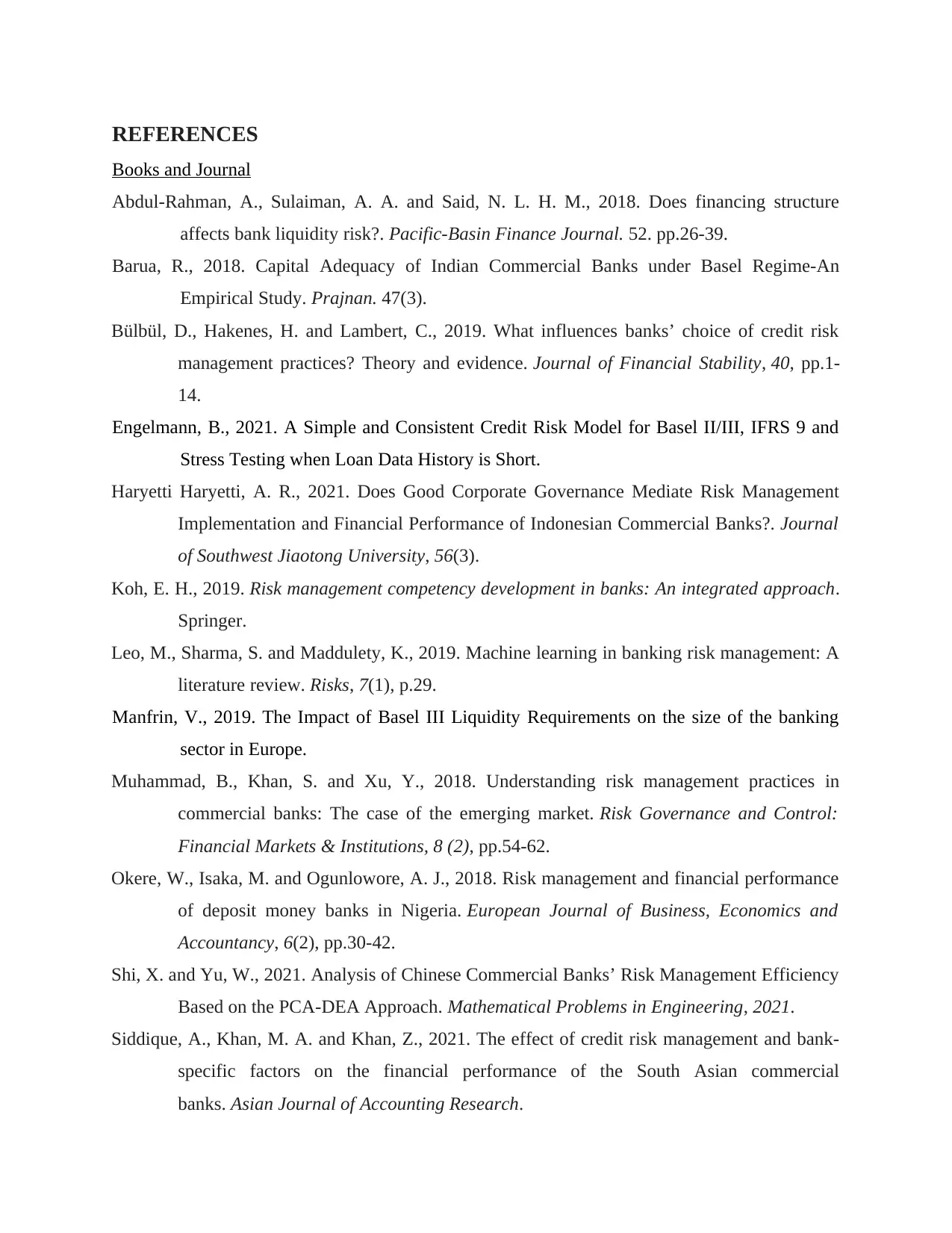
REFERENCES
Books and Journal
Abdul-Rahman, A., Sulaiman, A. A. and Said, N. L. H. M., 2018. Does financing structure
affects bank liquidity risk?. Pacific-Basin Finance Journal. 52. pp.26-39.
Barua, R., 2018. Capital Adequacy of Indian Commercial Banks under Basel Regime-An
Empirical Study. Prajnan. 47(3).
Bülbül, D., Hakenes, H. and Lambert, C., 2019. What influences banks’ choice of credit risk
management practices? Theory and evidence. Journal of Financial Stability, 40, pp.1-
14.
Engelmann, B., 2021. A Simple and Consistent Credit Risk Model for Basel II/III, IFRS 9 and
Stress Testing when Loan Data History is Short.
Haryetti Haryetti, A. R., 2021. Does Good Corporate Governance Mediate Risk Management
Implementation and Financial Performance of Indonesian Commercial Banks?. Journal
of Southwest Jiaotong University, 56(3).
Koh, E. H., 2019. Risk management competency development in banks: An integrated approach.
Springer.
Leo, M., Sharma, S. and Maddulety, K., 2019. Machine learning in banking risk management: A
literature review. Risks, 7(1), p.29.
Manfrin, V., 2019. The Impact of Basel III Liquidity Requirements on the size of the banking
sector in Europe.
Muhammad, B., Khan, S. and Xu, Y., 2018. Understanding risk management practices in
commercial banks: The case of the emerging market. Risk Governance and Control:
Financial Markets & Institutions, 8 (2), pp.54-62.
Okere, W., Isaka, M. and Ogunlowore, A. J., 2018. Risk management and financial performance
of deposit money banks in Nigeria. European Journal of Business, Economics and
Accountancy, 6(2), pp.30-42.
Shi, X. and Yu, W., 2021. Analysis of Chinese Commercial Banks’ Risk Management Efficiency
Based on the PCA-DEA Approach. Mathematical Problems in Engineering, 2021.
Siddique, A., Khan, M. A. and Khan, Z., 2021. The effect of credit risk management and bank-
specific factors on the financial performance of the South Asian commercial
banks. Asian Journal of Accounting Research.
Books and Journal
Abdul-Rahman, A., Sulaiman, A. A. and Said, N. L. H. M., 2018. Does financing structure
affects bank liquidity risk?. Pacific-Basin Finance Journal. 52. pp.26-39.
Barua, R., 2018. Capital Adequacy of Indian Commercial Banks under Basel Regime-An
Empirical Study. Prajnan. 47(3).
Bülbül, D., Hakenes, H. and Lambert, C., 2019. What influences banks’ choice of credit risk
management practices? Theory and evidence. Journal of Financial Stability, 40, pp.1-
14.
Engelmann, B., 2021. A Simple and Consistent Credit Risk Model for Basel II/III, IFRS 9 and
Stress Testing when Loan Data History is Short.
Haryetti Haryetti, A. R., 2021. Does Good Corporate Governance Mediate Risk Management
Implementation and Financial Performance of Indonesian Commercial Banks?. Journal
of Southwest Jiaotong University, 56(3).
Koh, E. H., 2019. Risk management competency development in banks: An integrated approach.
Springer.
Leo, M., Sharma, S. and Maddulety, K., 2019. Machine learning in banking risk management: A
literature review. Risks, 7(1), p.29.
Manfrin, V., 2019. The Impact of Basel III Liquidity Requirements on the size of the banking
sector in Europe.
Muhammad, B., Khan, S. and Xu, Y., 2018. Understanding risk management practices in
commercial banks: The case of the emerging market. Risk Governance and Control:
Financial Markets & Institutions, 8 (2), pp.54-62.
Okere, W., Isaka, M. and Ogunlowore, A. J., 2018. Risk management and financial performance
of deposit money banks in Nigeria. European Journal of Business, Economics and
Accountancy, 6(2), pp.30-42.
Shi, X. and Yu, W., 2021. Analysis of Chinese Commercial Banks’ Risk Management Efficiency
Based on the PCA-DEA Approach. Mathematical Problems in Engineering, 2021.
Siddique, A., Khan, M. A. and Khan, Z., 2021. The effect of credit risk management and bank-
specific factors on the financial performance of the South Asian commercial
banks. Asian Journal of Accounting Research.
⊘ This is a preview!⊘
Do you want full access?
Subscribe today to unlock all pages.

Trusted by 1+ million students worldwide
1 out of 13
Related Documents
Your All-in-One AI-Powered Toolkit for Academic Success.
+13062052269
info@desklib.com
Available 24*7 on WhatsApp / Email
![[object Object]](/_next/static/media/star-bottom.7253800d.svg)
Unlock your academic potential
Copyright © 2020–2025 A2Z Services. All Rights Reserved. Developed and managed by ZUCOL.





